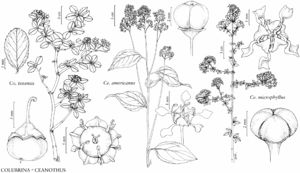Colubrina texensis
Boston J. Nat. Hist. 6: 169. 1850.
Common names: Texan hog-plum
IllustratedEndemic
Basionym: Rhamnus texensis Torrey & A. Gray Fl. N. Amer. 1: 263. 1838
Treatment appears in FNA Volume 12. Treatment on page 74.
Shrubs or small trees, erect, 1–2 (–2.8) m. Stems zigzag, white tomentose-sericeous, becoming glabrate. Leaves deciduous, sometimes fascicled on short-shoots; petiole 1–4 mm; blade ovate to elliptic, oblong-obovate, or obovate, 1–3 (–4) cm, subcoriaceous, base rounded to subcordate, margins shallowly serrate, teeth 10–20 per side, apex rounded, often apiculate, abaxial surface loosely sericeous, adaxial glabrate; pinnately veined, secondary-veins (2–) 3–4 pairs, arcuate, basal pair prominent. Inflorescences fascicles, 2–4 (–7) -flowered, or flowers solitary; peduncles absent; fruiting pedicels 5–13 mm. Capsules 6–9 mm.
Phenology: Flowering Mar–May.
Habitat: Fencerows, roadsides, disturbed sites, clay banks, shell ridges, loose sand, sandy loam, rocky limestone slopes and crevices, gravel hills, stream banks, alluvial terraces, gravelly flood plains, shrub-grasslands, mesquite shrublands, oak-mesquite, oak-juniper, and mesquite-hackberry woodlands.
Elevation: 0–800 m.
Discussion
Colubrina texensis is widespread in central and southern Texas.
Selected References
None.
Lower Taxa
None.
... more about "Colubrina texensis"
sericeous +
glabrate +
dehiscing +
apiculate +
rounded +
not gland-dotted +
ovate;elliptic oblong-obovate or obovate +
subcoriaceous +
absent +
Texan hog-plum +
Tex. +
bisexual +
dehiscent +
Fencerows, roadsides, disturbed sites, cla … Fencerows, roadsides, disturbed sites, clay banks, shell ridges, loose sand, sandy loam, rocky limestone slopes and crevices, gravel hills, stream banks, alluvial terraces, gravelly flood plains, shrub-grasslands, mesquite shrublands, oak-mesquite, oak-juniper, and mesquite-hackberry woodlands.juniper, and mesquite-hackberry woodlands. +
hemispheric +
2mm;3mm +
Present +
2-4(-7)-flowered +
fascicles +
axillary +
simple +
fascicled +
alternate +
deciduous +
serrate +
adnate +
intrastaminal +
absent +
fleshy +
3(-4)-locular +
basal +
inferior +
anatropous +
absent +
not fleshy +
absent +
not fleshy +
hooded +
opposite +
absent +
absent +
2-4-carpellate +
Boston J. Nat. Hist. +
1850 +
arcuate +
basal +
prominent +
valvate +
distinct +
spreading +
keeled;ovate-triangular;triangular +
longitudinal +
white +
1;4 +
absent +
connate +
Colubrina texensis +
Colubrina +
species +
fascicles +
unarmed +
small +
woody +

